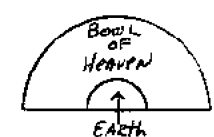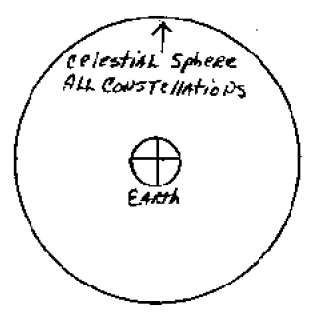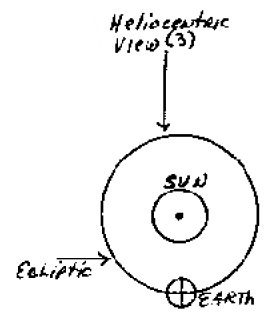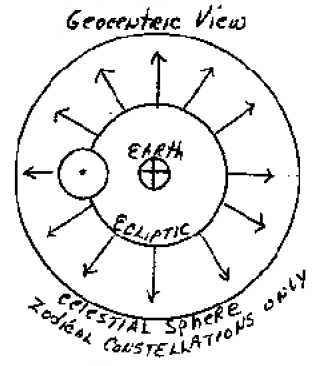by Marilyn Muir, LPMAFA

This work is licensed under a Creative Commons Attribution-NonCommercial-ShareAlike 4.0 International License.
Declination Math with Examples
Reading and Aspects, Latitudes
General Reading
What exactly is a Declination? I have no way to know the level of your understanding of Declinations and Latitudes so I can move forward into activations, and I cannot make assumptions. Therefore, I must take the time to teach you about Declinations and Latitudes from the ground up in order to be sure you can use this relatively brief material on progressing Declination and Latitude positions. Quoting from Nicholas DeVore’s Encyclopedia of Astrology – Declinations:
“…the manner of indicating distance north or south of the Celestial Equator. The maximum possible Declination of the Sun is 23 degrees, which occurs at the Solstices, when the Sun passes the Tropics (0˚ Cancer / Capricorn), the limit of the pole’s greatest inclination from the place of the Earth’s orbit. 0˚ Aries / Libra have no Declination as the Ecliptic intersects the Equator. However, planets at this longitude may have Declination. The maximum possible Declination of the Moon, Mercury and Mars is 27 N and on rare occasions, Venus reaches 28˚. Jupiter, Uranus, Saturn and Neptune have practically the same declination as the Sun.” Note: not listed in DeVore’s book as it is an old reference text, the maximum Declination of Pluto is 24 N 06.
To put this in a more understandable format, let us go back to the astronomical beginning and use some visual aids to help us. Ancient man believed that the flat Earth was overshadowed by a large inverted bowl on which the stars and planets were “painted” or affixed in some way. For convenience, modern astronomers and astrologers perform their calculations on a circular model which says Earth is in the center of a “celestial sphere”. Have we not come a long way? All the starry constellations of which we were aware ranged all over the surface of this celestial sphere.
The largest circle possible to cut through the celestial sphere that is going through the center of a body (in this example, the Earth) is called a great circle. Small circles donot go through the center of a body.
We know our Earth and the rest of the known planets orbit the Sun (see heliocentric diagram). As an optical illusion based on Earth’s personal perspective, it appears to us that it is the Sun that orbits the Earth (see geocentric diagram). This illusionary path of the Sun around the Earth, which is in reality the path of the Earth and the planets around the Sun, is called the Ecliptic. The Ecliptic passes through twelve of the many constellations. These 12 are called zodiacal constellations, our zodiac. The Ecliptic is a great circle (GC#1) measured by zodiacal signs and degrees.
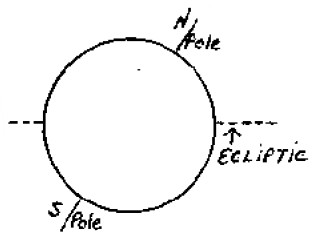
The north and south poles of the Earth are not at a 90˚ angle to the ecliptic. Instead, the Earth is tipped on its axis approximately 23.5˚, which varies slightly as the Earth wobbles while it rotates.
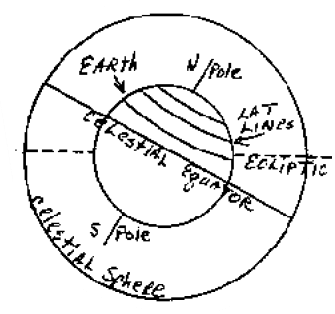
The great circle located on the Earth itself is called the Equator (see diagram). It passes around the middle of the Earth equidistant to the north and south poles. Degrees of terrestrial latitude are measured from the Equator (0˚) to the north and south poles (90˚) by small circles called Parallels of Latitude. These small circles are parallel to the Equator. If we were to extend this great circular equator line off into space until it touches the celestial sphere, it would be called the Celestial Equator (GC#2).
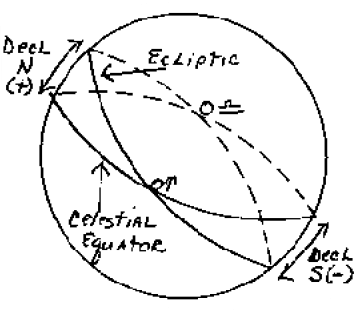
Since the Earth is tipped on its axis by 23.5 degrees, the celestial equator and the ecliptic (zodiac) meet only at two points, 00 Aries and 00 Libra, and then veer apart up to about 23.5˚ (Earth’s tilt) at 00 Cancer and 00 Capricorn (see diagrams). In brief, GC #1 is the ecliptic zodiac signs and degrees and GC #2 is the Celestial Equator (CE). Note: There are four other great circles that determine the angles of a chart, but that discussion is beyond the scope of this material.


Why would we consider Declinations in the first place? Again, visual illustrations will aid our comprehension. We are all familiar with the measurements of width, height and depth. If we had a dresser to place in a room, we must consider how wide it is, how tall it is, and how far out from the wall it would extend (see diagram). If we did not take these dimensions into consideration, we might have a problem fitting the dresser into the place reserved. When we read a chart using common zodiacal longitudinal aspects only, we are investigating and interpreting only one dimension of a person, let us say their width. However, the person also has height and depth. My favorite analogy is from the Star Trek television series – Mr. Spock’s three-dimensional chess board. He not only played chess in the back-and-forth positions that are common, he had three levels on which to play that created a multiple-dimension chess match.


To add to the dimension of depth, we turn to the Earth and to the great circle called the CE. As you noticed in the previous diagrams, the 23.5˚ spread that can occur between the CE and the Ecliptic can easily place planets south or north of the CE. This is called Declination or how far a planet “declines” from the CE (see diagram). To simplify our view, all planets located north of the Equator in their orbits are in North Declination. All planets located south of the Equator are in South Declination (see diagram). Please remember north and south or up and down are arbitrary, but agreed-upon, human references. There is no true up / down, north / south, etc. in open space, but humans need standard reference points.
Where the CE and the Ecliptic meet in a south to north direction (down to up), we find 0 Aries. Where the CE and the Ecliptic meet in a north to south (up to down) direction, we find 0 Libra. These are called the Equinoxes, where we experience equal days and nights. Where the maximum possible Declination of 23.5˚ occurs between the CE and the Ecliptic, we have 0 Cancer and 0 Capricorn, the longest day and the longest night of the year respectively. This explanation gives us one more of the three dimensions of being, width, height and depth; or astrologically speaking, longitude, latitude and declination.
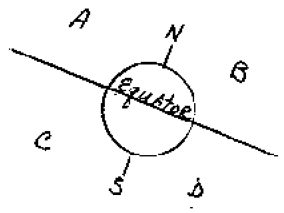
AspectsIf two or more planets are both north or both south and within orb, they are considered to be parallel. If one is north and one is south and within orb, they are considered to be contra-parallel (see previous diagram). The symbols to be used are as follows:
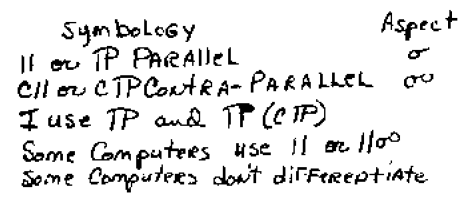
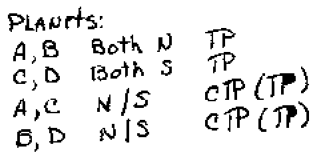
Ephemeris Computing Declination is easy if you have a computer. Most reasonable programs will give you Declinations and Latitudes on all their charts. If not, you must have an ephemeris that lists both Declinations and Latitudes for the next part of this lesson. The best ephemeris for that is Neil Michelsen’s very large The American Ephemeris (not the 100-year small book we are all familiar with). I have copied a month (November, 1938) so you can see what it looks like. The American Ephemeris I have as described above is from 1931 to 1980 (copyright 1980). This may be out of print, so check for used books.
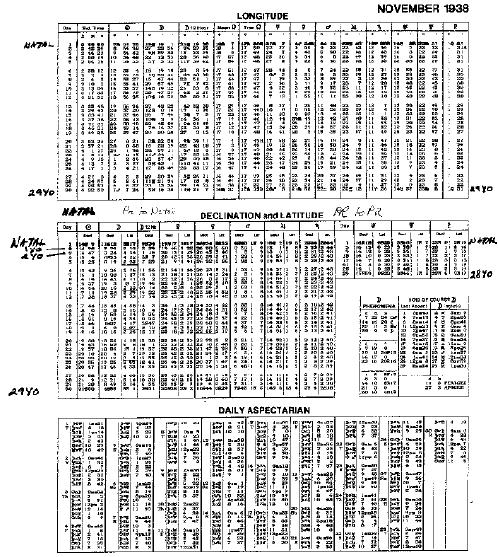
Alternatively, you may use the Hieratic fifty-year ephemerides that listed Declinations. The old Rosicrucian Ephemeris that was very popular at one time, but was notorious for error, lists both Declinations and Latitudes. Earlier years did not list Pluto as it was not discovered until 1930. It is possible that newer editions have rectified both the errors and the possible omission of Pluto. I have only my original books for reference. Other earlier ephemerides do not give the Pluto Declination. Lynn Palmer authored a 100-year Pluto Ephemeris (1900-2000). Since most astrologers currently use computer charts, each program could have slight differences.
I have a number of other references on my bookshelves as I am a book collector, but I do not know if they are currently available. It is also possible that there are websites with the information available, or free chart casting sites with the information available. Just be sure such website charts are accurate. If you were to take an astrological exam, this could be part of the test, so you would need a physical ephemeris.
Declination Math
The Rosicrucian ephemeris lists the planets for Declination and Latitude every two days. Hieratic lists them every three days, and Michelsen every day. Do pay attention to the order of the planets as listed in the Rosicrucian ephemerides as they do not necessarily follow the usual arrangement, listing instead by average speed of orbit, fastest to slowest. Obviously, we always want to work with the most accurate information available. An accurate computer printout would give the best possible results because the programs work on algebraic equations, compared to more rigid and static printed tables used when calculating by hand.
The positions may show + and – listings where + stands for north and – stands for south. Actual motion, motion of exactitude or determining whether applying or separating is not always recognized by computer printouts. You will need the ephemeris. It is very easy to determine these factors using an ephemeris. The motion of most of the planets on a daily basis is quite small. If the ephemeris lists declinations every day, you may take them out of the book without correction for general purposes. Their daily movement is slight, with the exception of the Moon. If you were to take a test, you would have to make the exact calculation just to show you have the skill to obtain the correct figure.
To get a daily position, simply calculate the total motion. Subtract the lower position from the higher position between the two dates listed. Exception: if the listing is changing from N to S or S to N, add the two position figures together to determine the daily motion. Divide the total motion by the number of days between listings to determine the daily motion. You can use logarithms or diurnal motion tables, if you prefer, in the same manner as planetary motion (see example page). The American Federation of Astrologer (AFA) exam requires correction for the planets only to the day, with the exception of the Moon. The Moon’s declination must be corrected for the time interval to GMT. (Note: These were the rules in play at the time this material was originally written).
Plus or minus the small daily motion to the closest listing?
- If the listings are increasing in position, treat it as a direct planet.
- If the listings are decreasing in position, treat it as a retrograde planet.
- If the listing is changing from N to S or S to N, determine your base (the closest position).
- If the daily motion is smaller than the base position, simple subtraction is required, and the remainder is the degree and minute of the desired position. Direction N or S does not change from the base for this example.
- If the daily motion is higher than the base position, again subtract the lower number from the higher number, the difference is the degree and minute of the desired position.
- However, if the direction moves between N or S the answer will be the opposite of the base position because you have crossed 0 Declination.
To correct more accurately for a time interval or for the Moon (and here I must assume you know how to construct a natal chart), first correct to the daily position using the instructions just given and note if your base is from a midnight or noon ephemeris. Using your GMT, correct for the smaller interval as you would any planet by logarithm or diurnal motion. For example, a 7 pm EST birth would be midnight of the next day in a midnight ephemeris or 7 hours past noon in a noon ephemeris. In this example, the listings for midnight GMT could be used without correction. For the noon ephemeris in this example, using the daily total motion, determine the motion for the shorter interval required by the GMT and plus or minus to your day’s base position. Note if you switch between N and S, and calculate as given.
Planets at farthest Declination appear to move very slowly due to the fact that, from our perspective, they are turning around in space. As they are going through the sinewave pattern, much change in actual speed is not occurring, it is merely an optical illusion based on our individual perspective. The Sun at 0 Aries or Libra has no Declination.
To obtain the declinations of the Ascendant, Midheaven, part of fortune or any other point or part, use your ephemeris to look up the longitudinal position of the Sun as close as the degree and minute desired. Use any year and use the Declination listed. Make corrections only as required. Make a vertical list of the Declination positions for ease in determining declination aspects. Do not do Declinations or Latitudes to primary directions, as the directions are artificial positions.
Math Examples for Declinations
N to N or S to S direct:
Moon 3/19 00 N 31 17˚ divided by 3 days = 5˚ with 2˚ remainder
Moon 3/22 18 N 18 2˚ x 60’ = 120’ + 47’ = 167’ ÷ 3 days = 56’ or 5˚56’ daily motion
days 3 17˚ 47’ If you want 3/20, use 3/19 as your base and add your daily motion:
00 N 31 + 5˚56’ = 6 N 27.
If you want 3/21, use 3/22 as your base and subtract one day’s motion:
18 N 18 minus 5˚56’ = 12 N 27
Your answer must always fall into the degrees between the two dates listed.
N to N or S to S retrograde:
If the listing were 18 N 18 on the 19th and 00 N on the 22nd, treat the math as if you were correcting a retrograde natal planet. The math to produce the three-day total motion and the derivative daily motion would remain the same. However, the plus and minus would be reversed. If the date you want is the 20th, you would still use the base position of the 19th; but would add your daily motion. If the date you want is the 21st, you would still use the base position of the 22nd, but would minus the daily motion. Please re-read this carefully. It is not difficult, but it can be confusing.
N to S or S to N (sine wave motion):
0 N 17 12/1 1˚59’ = 119’ divided by 3 days = 40’ per day, plus or minus?
1 S 42 12/4 If you want 12/3, then use 12/4 as your base and back up: 1 S 42 – 40’ = 1 S 02
1˚ 59’ 3 days If you want 12/2, then use 12/1 as your base and move forward: 40’:
(add 2 positions) 0N 17 – 40’ = 23’ remainder, reverse N to S = 0 S 23.
Noon or midnight ephemeris:
Previous instructions have been given for the differences between the ephemeris bases and how to compensate. The instructions have not changed. The rate of travel for both Declinations and Latitudes is much smaller. Be very careful with direct and retrograde motion. Note: The samples provided with this lesson are midnight-based.
Reading and Aspects
I have found few references to delineation books on Parallels of Declinations or Latitudes. All that is available pertains to the two Declination aspects possible, parallel and contra-parallel. What is meant by the two terms? As shown in the above diagram, planets N to N or S to S within orb are considered to be in parallel. Planets N to S within orb are considered to be contra-parallel. Parallels, which are less visible and accessible, do seem to act more slowly and subtly, but have the distinct nature of a conjunction. They give intensity and concentration to the planets involved. Contra-parallels have more of the nature of an opposition and can act more insidiously, or as a slowly separative influence. An illustration would be that of a forceful coming-apart (opposition) or a slow easing-apart concept (contra-parallel). Apart is apart, regardless of how long it takes to happen.
I can suggest two books that will help you work with each pairing. Reinhold Ebertin’s Combination of Stellar Influences and the more modern Mike Munkasey’s Midpoints are marvelous books for multiple purposes and applications. I use them in both relationship readings and composite charts. The combinations are easy to apply. Look up the pairing for the planets involved.
Orb The allowed orb for Declination is generally 1˚ to 1.5˚. I have seen higher orbs, but do not use them. Remember that in space 1˚ is a vast distance. If the orb is questionable, you can check for applying and separating, much the same as a natal planet. An aspect that has been in orb and is widely separating is weak and getting weaker than an aspect that is coming into formation (applying), and getting stronger, even when wide.
Latitudes
This is the third dimension of aspects, along with Longitude and Declination. Again from DeVore’s Encyclopedia: “There are three kinds of Terrestrial Latitude: astronomical, geographic and geocentric. Astronomical and geographic are our latitude measurements on the globe itself; and are based on the Equator as the dividing line between north and south. Geocentric, the subject of our study is measured north of south of the Ecliptic and is called celestial latitude. Since the apparent motion of the Sun, resulting from the Earth’s motion in orbit, is itself the Ecliptic, the Sun can have no latitude. Since the orbits of the planets are inclined to the Ecliptic at an angle, each increases in latitude as it approaches the square to its nodes, half of the orbit in north latitude, half of the orbit in south latitude.”
Maximum latitude of the Moon is 5˚17’, Mercury 7˚, Venus 0˚24’, Mars 1˚51’, Jupiter 1˚18’, Saturn 2˚29’, Uranus 0˚46’, Neptune 1˚47’, and Pluto 17˚9’. As you can see, only eccentric Pluto veers widely from the ecliptic in a north to south latitude.
The instructions for determining the Latitude are the same as for Declinations. However, the rate of motion from day to day is very small, so the corrections are minute. Simply use the latitude tables directly from the ephemeris unless you are being tested. Exact measurement indicates you have the skill. Orbs for determining conjunctions or oppositions are only 12’, very tight. N / N or S / S would be conjunction. N / S would be oppositional.
Natal, transiting or progressed latitudes work as readily as Declinations. Do not direct the latitudes for the same reason as given previously – it’s pointless. To progress, simply use the same progressed date in the ephemeris as you do for the longitude positions. Aspect progressed to progressed, progressed to natal, or transit to transit and transit to natal. I have never examined transit to progressed… hmmm, more study.
Graphing For purposes of visual clarity, my students and I used a piece of graph paper to use points to layout the natal planets on one side and progressed planets on the other side. It would then be simple to note those periods of time within 12’ orb when aspects between those two bodies would be in effect by progression. This would indicate aspects that could take years to develop or diminish. This same graph concept could be used for Declinations as well, with a 1˚ orb. I have provided a copy of the Declinations graphing. I personally had a progressed Saturn to Venus Latitude aspect that was not particularly visible using any of my other chart techniques. However, this was a painful, long-lasting (eighteen-month) and very karmic lesson. Latitudes and progressed latitudes do work!
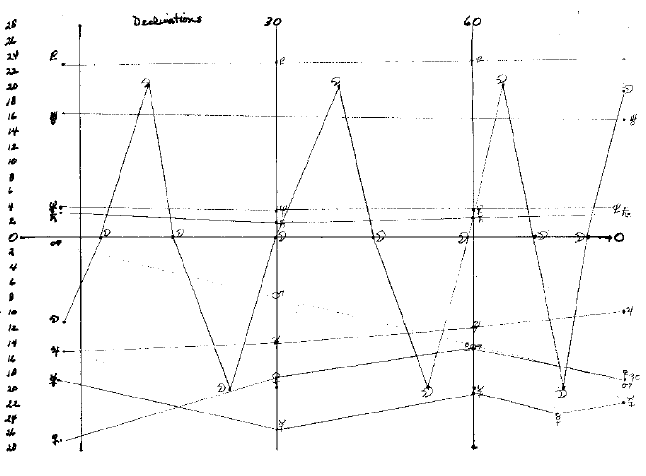
General Reading
Using Declination and Latitude offers the other two dimensions of the three-dimensional person.
- It is possible for new aspects to emerge, giving more information to the astrologer and the client.
- Known aspects may be reinforced by a similar pattern, adding more impact to such previously known aspects.
- A contradictory influence may emerge from Declinations or Latitudes to the known longitudinal aspect. This cannot only create new insights but can also shade or alter traditional meanings.
- A longitudinal hard aspect may not be as stressful if countered by a Declination or Latitude softer aspect.
- A longitudinal positive aspect may not be as beneficial if stressed by a Declination or Latitude hard aspect.
- This may alter the advantage or disadvantage of our more easily visible longitudinal aspects.
- If planets were conjunct by combinations of longitude, latitude and declination, the aspect should be very powerful.
- The rule of thumb is that longitudinal aspects act more visibly and rapidly, while Declination or Latitude aspects act more slowly, less visibly, more subtly.
- A planet at farthest elongation (farthest out, high number) can be somewhat dissociative in the manner of an unaspected planet.
In terms of priority, it is my suggestion that you do and compare aspects first, then apply the information through the house systems to see just where the arena in the life is affected, and then read the signs as methods of expression or mannerisms.
Also, as previously noted in the declinations material, aspects by Declination or Latitude could support, negate or modify our normal zodiacal longitudinal aspects. For example: a sextile by longitude between Mercury and Neptune would be seriously weakened by an opposition by Declination or Latitude, whereas a conjunction by Declination or Latitude should support that sextile.
Reading As suggested in the declinations material, your best source of information as to how to apply these aspects in a reading is from Mike Munkasey’s Midpoints, Ebertine’s Combination of Stellar Influences, or any general reference text that delineates conjunctions or oppositions between the specific bodies in the aspect.
- If it is a conjunction, read the more positive keywords and understand the principles are unifying and attempting to learn how to cooperate. It is difficult to separate the energies involved. They always seem to act in unison for better or for worse.
- If it is oppositional in nature, use the more negative keywords and understand the principles are confrontive and tend to act at odds with each other and may act separative in nature.
- Also take into account the natural working of each planet and the common interaction of the aspect itself.
Progressions for both Declinations and Latitudes When doing progressed Declinations, the math is the same as the natal. Only the Moon moves fast enough to warrant interpolation. To progress, simply use the same progressed date in the ephemeris as you do for the longitudinal positions. Natal, transiting or progressed Latitudes work as readily as Declinations. Again, do not direct either the Declinations or the Latitudes. Use a tight 12’ (Latitude) or 1˚ (Declination) orb, recognizing that closer is stronger.
In reading progressed Declinations, read both progressed to natal and progressed to progressed as new aspects can form. If using transiting Declinations, aspect transit Declination to transit, then transit to natal and then to progressions. Do not apply transiting Declinations to primary directions.
The year of the exact progressed aspect can be the year the impact of the aspect is felt most strongly.

This work is licensed under a Creative Commons Attribution-NonCommercial-ShareAlike 4.0 International License.
